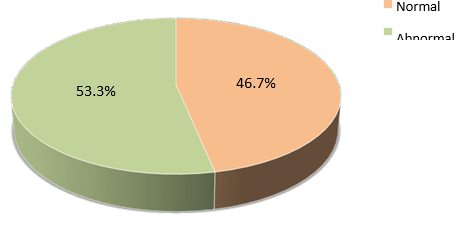Pattern of presentation in clinically diagnosed epileptic patients
Abstract
Background: Diagnosis of epilepsy is based mainly on clinical history and examination. EEG constitutes the single most valuable laboratory test in the evaluation of patients with epilepsy. It is a safe, non-invasive procedure for evaluation of electrophysiological state of patients with epilepsy. Objective: To find out the Pattern of presentation in clinically diagnosed epileptic patients. Methods: This cross-sectional study carried out in the Department of Neurology, Bangabandhu Sheikh Mujib Medical University, Dhaka, Bangladesh. A total of 152 epileptic patients attended in the Epilepsy Clinic of the Department of Neurology were enrolled for this study. Information on socio-demographic and seizure characteristics was obtained. The recordings from patients were obtained using the standard. Results: A total of 152 patients were recruited. Maximum patients (43.4%) were in age group 11-20 followed by 37 (24.3%), 27 (17.8%), 13 (8.6%) and 9 (5.9%) were in age groups 21-30 years, 1-10 years, 31-40 years and >40 years respectively. Male (62.5%) were predominant than female (37.5%). Male female ratio was 1.67:1. Distribution of patients according to common presenting features. Out of 95 patients most common clinical features were generalized convulsion 63.2%, frothy mouth 61.8%, loss of consciousness 59.9% and tongue bite 57.2% in case of generalized seizure and in focal seizure most common was abnormal movement (20.4%). Most of the patients (50.7%) had GTCS followed by 19 (12.5%), 18 (11.8%), 13 (8.6%), 13 (8.6%) and 12 (7.9%) patients had focal seizure without impairment of consciousness, focal seizure with secondary generalization, absence seizure, focal seizure with impairment of consciousness and myoclonic seizure respectively. Among distribution of abnormal EEG findings in patients with generalized seizure. Of them 56 (87.5%) patients had generalized epileptic discharge and 8(12.5%) patients had typical absence seizure. Conclusion: Based on the above study it can be concluded that diagnosis of epilepsy is based on clinical history and examination. The most common clinical presentation of epileptic patients is generalized seizure, generalized convulsion and frothy mouth help to clinical diagnosis of epilepsy, assist in planning drug management and determining prognosis.
Downloads
References
Chowdhury, R.N., Hasan, A.T.M.H., Rahman, K.M., Mondol, B.A., Deb, S.R. and Chowdhur,y Q.D.M. (2013) ‘Interictal EEG changes in patients with seizure disorder: experience in Bangladesh’, Springer Plus, 2:27
Allen, C.M.C., Lueck, C.J., Dennis, M. (2010) Neurologic disease. In: Colledge NR,Walker BR, Ralston SH (eds) Davidson's Principles and Practice of Medicine, 21st edn. USA: Elsevier Limited, p 1172
Palmini, A., Andermann, F., Olivier, A. (1991). Focal neuronal migration disorders and intractable epilepsy: a study of 30 patients. Annals of Neurology, 30: 741-749.
Yacubian, E.M.T. (2000) ‘Epilepsia: o conceitoatual. In: Yacubian E.M.T. (ed) Epilepsiada Antiguidadeao Segundo Milenio. Lemos, Sao Paulo, pp 82-8.
Marino, R. Jr, Cukiert, A., Pinho, E. (1986) ‘Aspectosepidemiologicos da epilepsiaemSao Paulo: um estudo de prevalencia’, Arquivos de Neuro- Psiquiatria, 44(3):243-54.
King, M.A., Newton, M.R., Jackson, G.D. (1998). Epileptology of the first seizure presentation: a clinical, electroencephalographic, and MRI study of 200 consecutive patients. The Lancet, 352; 1007-11.
Adams, R.D., Victor, M., Rooper, A.H. (eds) (2005) Epilepsy and other seizure disorder, Principles of Neurology, 8th edn, New York, USA: Mc Graw Hill Book Company. 271-95
Cascino, G.D. (2001) ‘Use of Routine and video encephalography’, Neurologic clinics, 19;277-87
Berkovic, S.F., McIntosh, A., Howell, R. (1996). Familial temporal lobe epilepsy: A common disorder identified in twins. Annals of Neurology., 40:227- 235.
Raymond, A.A., Fish DR, Sisodiya SM (1995). Abnormalities of gyration, heterotopias, tuberous sclerosis, focal cortical dysplasia, microdysgenesis, dysembryoplastic neuroepithelial tumour and dysgenesis of the archicortex in epilepsy. Brain, 118: 629-660.
Taylor, D.C., Falconer, M.A., Bruton, C.J. (1971). Focal dysplasia of the cerebral cortex in epilepsy. Journal of Neurology, Neurosurgery, and Psychiatry, 34: 369-387.
Forsgren, L. and Hesdorffer, D. (2009) ‘Epidemiology and prognosis of epilepsy’, In Shorvon S, Perucca E and Engel J, (eds), The Treatment of Epilepsy, 3rd edn. London, UK: Wiley-Blackwell, 21–31.
Owolabi, L.F., Shehu, S., Owolabi, S.D., Umar, M. (2013) ‘Interictal electroencephalography in patients with epilepsy in northwestern Nigeria’, Annals of Nigerian Medicine, 7(2): 48-54.
Sidig, A., Hussein, A., Yassien, F., Hamad, A., el-Adil, O., Saad, M., Mubark, B. and Aldar, M.M. (2011) ‘The pattern of clinical presentation of epilepsy among adolescence Sudanese epileptic patients’, Journal of Neuroscience and Behavioural Health, 3(1):1-7.



























